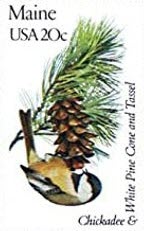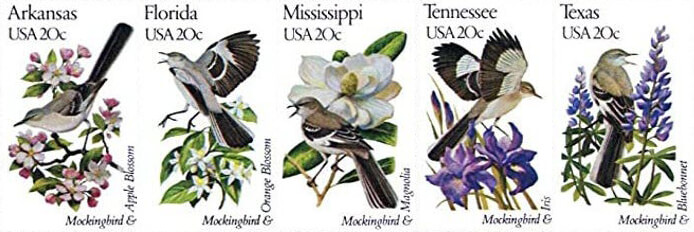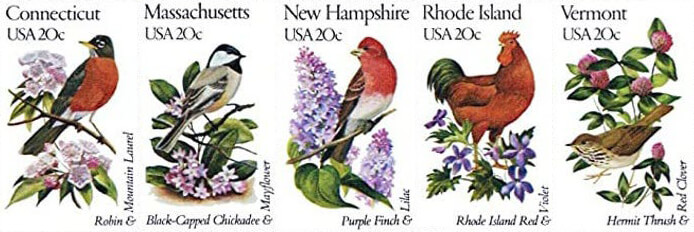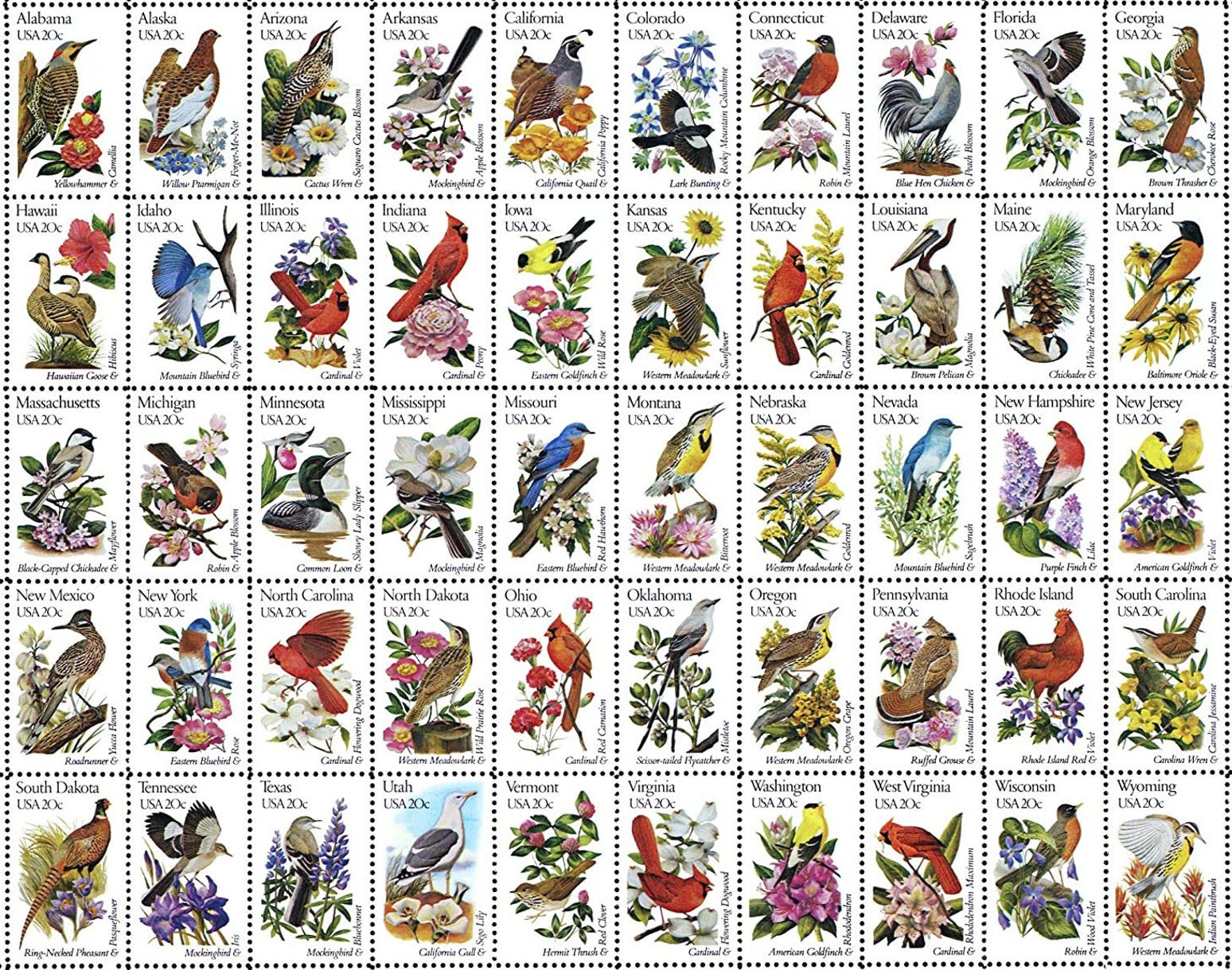Martha Steele

The state bird of Maine is the "chickadee."
In early March 2019, news stories highlighted a controversy in Maine about whether to change its official state bird from "chickadee" to either Boreal Chickadee or Black-capped Chickadee. Some preferred the Boreal Chickadee because Massachusetts already had the Black-capped Chickadee as its state bird and the Boreal Chickadee was more characteristic of Maine. Maine's legislature eventually chose not to propose any change in its state bird name and hence, the nonspecific chickadee remains the official state bird.
The news stories piqued my curiosity about state birds in general. The first states to name state birds did so in 1927. Over time, all states designated a state bird, with the last state being Arizona (Cactus Wren) in 1973. Maine is only one of two states that does not have a specific species, the other being Utah, whose state bird was codified generically in 1955 as "seagull," but was understood to be the California Gull (more on that below).
When reviewing the list of state birds through today's lenses, some choices may be surprising or even puzzling, while others may seem to be more of a convenience rather than a careful consideration of what bird to choose to represent the state. However, it is probably important to note that these decisions were largely made long before backyard and more serious birding became popular, and before travel focused on seeing the birds that are characteristic of a region or state and could result in tourist and economic benefits to local communities. For example, the American Robin was chosen in 1931 by Michigan as its state bird because it was the best known and most beloved bird. Today, some might give consideration to the Kirtland's Warbler for Michigan, given the influx of birders who visit the state perhaps solely for this bird, which occurs only in a specific area of that state and nowhere else in North America.
Still, it is fun to look at the state birds and contemplate what the choices might be if they were made today. To start, the most common state bird is the Northern Cardinal, which adorns seven states. Next comes the Western Meadowlark (six states) and Northern Mockingbird (five states). Three states have the American Robin as their state bird.

The Northern Mockingbird is the state bird for five states, including Florida and Texas.
In some cases, there is a documented rationale for why a state selected a particular bird. For example, in 1955, Utah selected the "seagull" as its state bird, further stating that by common consent, the state bird was the California Gull. The selection was based on the gull's role in protecting the state's agriculture during an 1848 invasion of crickets. Reportedly, huge numbers of California Gulls descended to feast on the crickets, thereby saving the crops.
Alabama selected a bird by the name of the Yellowhammer in 1927. This was supposed to represent what was then called the Yellow-shafted Flicker, with the phrase Yellowhammer referring to Alabama troops in the Civil War who wore yellow bands on their uniforms.
Delaware adopted the Blue Hen Chicken as its state bird in 1939 in recognition of a Delaware unit in the Revolutionary War that took these game birds, noted for their fighting ability, with them. When the men were not fighting, they entertained themselves with cock fights that became well known throughout the Army. Reportedly, when members of the troop fought valiantly in battle, they were compared to these fighting cocks.
Several states have state birds whose names have changed since the official state proclamation, such as the Eastern Goldfinch (adopted in 1935 by New Jersey), now called the American Goldfinch. In Washington, the state bird is Willow Goldfinch, adopted in 1951, and yet another name for American Goldfinch.
Interestingly, many states could choose a bird that more closely represents their state. Northern Mockingbird is the state bird for arguably the two birdiest states in the country, Florida and Texas. Florida and Texas? There seem to be so many other possibilities for these states. For starters, in Texas, we can think of Golden-cheeked Warbler or Black-capped Vireo. We can also think of Zone-tailed Hawk or the beautiful Aplomado Falcon. Anything but Northern Mockingbird, please. For Florida, birders enjoy many waders, such as Roseate Spoonbills, that are also a draw to the region for tourists.
Many states chose birds that still seem appropriate for today: Minnesota (Common Loon), Louisiana (Brown Pelican), Alaska (Willow Ptarmigan), California (California Quail), Maryland (Baltimore Oriole), New Mexico (Greater Roadrunner), Oklahoma (Scissor-tailed Flycatcher), and Vermont (Hermit Thrush).
Some groups are not represented at all among the fifty states. No raptors made any state bird, although the national bird is the Bald Eagle. No warbler, duck, seabird, or shorebird made the cut.

The state birds of Connecticut, Massachusetts, New Hampshire, Rhode Island, and Vermont.
And some states could have state birds connected to their state names. Could the Tennessee Warbler be the state bird of Tennessee instead of its current Northern Mockingbird? Could the Connecticut Warbler be the state bird for its namesake instead of the American Robin? South Carolina originally designated the Northern Mockingbird as its state bird, but in 1942 changed to the Carolina Wren, which many birders may consider more appropriate.
Some of you may remember the U.S. Postal Service (USPS) issuing commemorative twenty-cent stamps in 1982 that featured the state birds of all 50 states. Arthur and Alan Singer of Jericho, New York, were the first father and son team to design stamps for the USPS. Each stamp had the state bird, designed by Arthur, and the state flower, designed by Alan. Each stamp was different even when a particular species (e.g., Northern Cardinal) was the same for multiple states. Two states, North Carolina and Virginia, even had the same bird (Northern Cardinal) and same flower (flowering dogwood).
For your enjoyment, here is a list of state birds.
- American Robin: Connecticut, Michigan, Wisconsin
- Baltimore Oriole: Maryland
- Black-capped Chickadee: Massachusetts
- Blue Hen Chicken: Delaware
- Brown Pelican: Louisiana
- Brown Thrasher: Georgia (the "Bobwhite Quail," or Northern Bobwhite, is the state game bird)
- Cactus Wren: Arizona
- California Gull (codified as Seagull): Utah
- California Quail: California
- Carolina Wren: South Carolina
- Chickadee: Maine
- Common Loon: Minnesota
- Eastern Bluebird: Missouri, New York
- Eastern (American) Goldfinch: Iowa, New Jersey
- Greater Roadrunner: New Mexico
- Hermit Thrush: Vermont
- Lark Bunting: Colorado
- Mountain Bluebird: Idaho, Nevada
- Nene (Hawaiian Goose): Hawaii
- Northern Cardinal: Illinois, Indiana, Kentucky, North Carolina, Ohio, Virginia, West Virginia
- Northern Mockingbird: Arkansas, Florida, Mississippi, Tennessee, Texas (the Wood Duck is the official state waterfowl of Mississippi)
- Purple Finch: New Hampshire
- Rhode Island Red: Rhode Island
- Ring-necked Pheasant: South Dakota
- Ruffed Grouse: Pennsylvania
- Scissor-tailed Flycatcher: Oklahoma (the Wild Turkey is the state game bird)
- Western Meadowlark: Kansas, Montana, Nebraska, North Dakota, Oregon, Wyoming
- Willow (American) Goldfinch: Washington
- Willow Ptarmigan: Alaska
- Wood Thrush: Washington, D.C.
- Yellowhammer (Northern Flicker): Alabama
Martha Steele, a former editor of Bird Observer, has been progressively losing vision due to retinitis pigmentosa and is legally blind. Thanks to a cochlear implant, she is now learning to identify birds from their songs and calls. Martha lives with her husband, Bob Stymeist, in Arlington. Martha can be reached at marthajs@verizon.net.

The 1982 U.S. Postal Service state bird stamp set was designed by Arthur and Alan Singer of Jericho, New York.